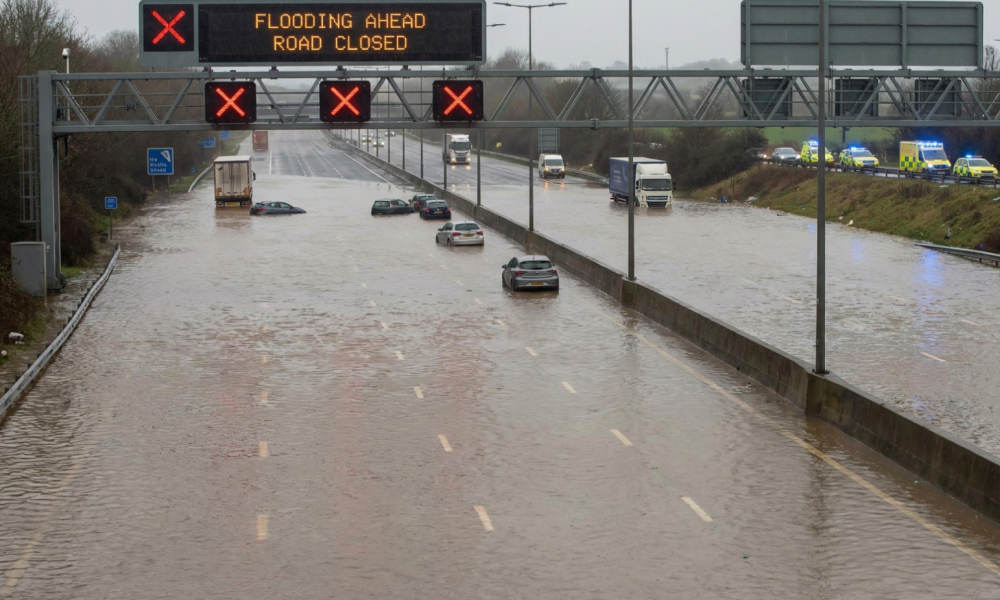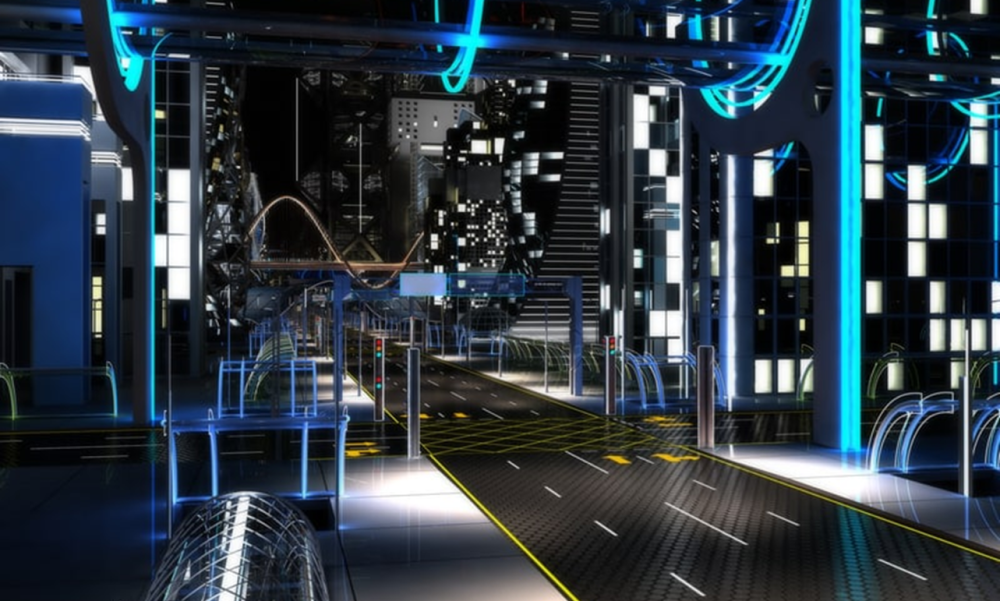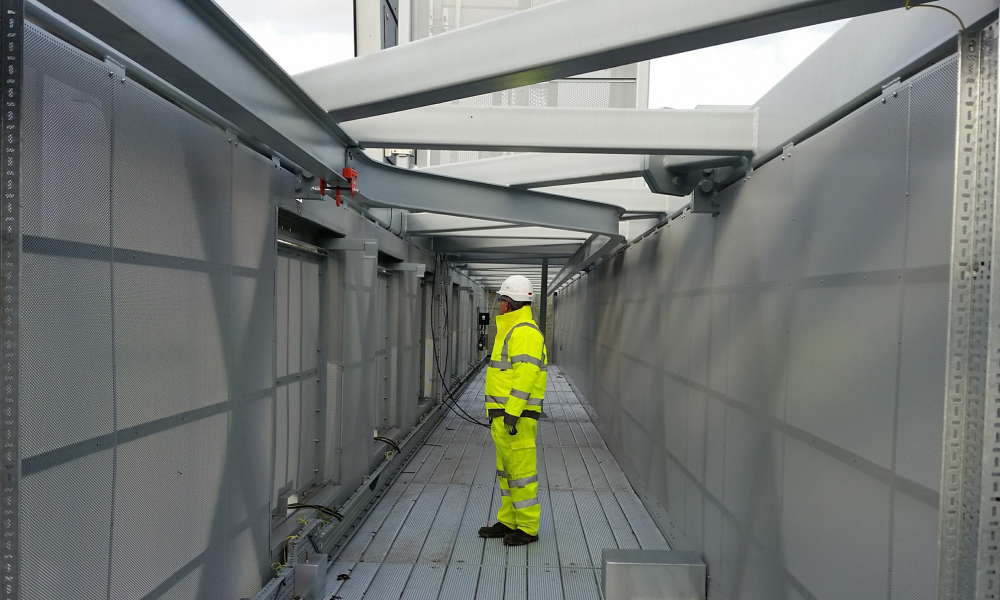Some might say that we aren’t actually affected by extreme climatic events, but this sort of scene is becoming increasingly familiar to many, we have seen many instances in recent years of flooding events, this example of a flooded motorway gives an indication of how technology installations could easily become compromised.

Although the majority of flooding events are thankfully localised, this will not help if ITS equipment is located in a low point. We might feel that snow won’t cause much of an issue to ITS installations.An unintended consequence of changing to LED traffic signals in locations which get significant snow falls, is the fact that the halogen bulbs in older installations used to melt the snow on the signal heads, maintaining visibility, but the new heads don’t get warm enough to do this, resulting in a requirement to manually clear them in some locations. And in these conditions, if equipment needs maintenance activities to be carried out, it can not only be difficult to get to the locations, but it may also not be a safe thing to open cabinets in poor weather conditions. In a lot of locations, dust storms are increasingly causing problems, which like snow, can make undertaking maintenance activities both difficult and dangerous to undertake. But in these locations, heat is the main issue that needs to be mitigated against. Even though many highway corridors in areas where bush type fires are more likely to occur, often deliberately have little vegetation near to the carriageway, the transmission path for these events can result in devastation for vehicles and equipment. The design of ITS features will need to consider how it will stand up to worsening wind and storm events. One of the most devasting issues we do have to face is lightning and although we are probably all aware of the issues of lightning striking overhead structures, the impact this has on connected equipment/systems needs to be considered.

The operation of our streets and highways, which in many areas have been at the forefront of technology adoption to manage traffic flow over the years, will need to make a huge step change to be relevant as vehicle technologies and wider online applications come to the fore. Traditional Intelligent Transport Systems (ITS) deployments have largely followed a ‘top-down’ heavy engineering model, where a traffic authority will ‘build’ a centralised system to provide a predetermined set of operational features and capabilities. These systems typically use information from inputs which are specifically provided for a task, then provide outputs which use built features to achieve the required outcomes. So, as an example, early Traffic Signal installations used vehicle detectors to provide the roadside Traffic Signal Controller information about the traffic on each approach to a junction, which allowed the signals to respond flexibly to meet the current demand. However, these couldn’t coordinate with other junctions or make use of information from other sources to best optimise their operation. So, to overcome this, most cities installed Urban Traffic Control systems to achieve a more holistic approach to traffic control, and over the years these systems have become increasingly sophisticated and able to communicate with wider and wider types of infrastructure. However, in the same way as with those early sets of isolated traffic signals, our modern-day traffic systems will need to respond to the needs and expectations of new requirements, and be more capable of operating with less centralised systems topographies as part of a much wider overall technology landscape. Although there has been much speculation about the way in which Automated Vehicles will impact the architecture and operation of Intelligent Transport Systems, the introduction of Connected Vehicles in significant quantities will actually inevitably impose a significant step-change to how we currently manage and operate our highways, and subsequently the ITS infrastructure will need to respond to this. Because of this, much of the heavy engineering solutions we are currently installing are likely to become obsolete before we would have expected these installations to have become life expired. Our normal expectation is for equipment to last 15 years or more, but there are huge numbers of installations of all sorts of traffic installations which are in excess of 25 years out on the network. I think this illustrates the enormity of the task which we are going to face over the coming years to be able to upgrade or replace equipment in the most appropriate way to respond both to the increased pace of technology change and to reduce their ongoing impact on the environment. Takeaway #1 - Our traditional engineering mindset of building longevity into every element of what we install, will need to change to achieving this as part of a system of systems rather than for each individual piece of equipment.

When we look at modern Intelligent Transport Systems, we see that most types of equipment now use modern, energy efficient electronic components, that significantly reduces the amount of power which they consume when operating, so that as designers and operators of these systems we probably feel that we have made major strides in achieving carbon reductions in our strive to protect the environment. However, many modern Intelligent Transport Systems deployments actually consist of huge engineering construction projects to achieve the benefits of the technology deployments. Major civil’s, structural and geotechnical schemes are often required to mount equipment on, as an example, these full-span motorway accessible gantries are in themselves significant engineering installations. When you whizz past these structures at 60-70 miles an hour, most users will not really be aware of their sheer size, it is only when you get inside them that you really appreciate what they amount to. Now obviously, these structures use a lot of energy to manufacture them, to construct and install their various elements, and to maintain over their lifecycle. So, what we really need to do is to review the requirement for these installations in the first place, especially given the context of the overall changes to the technology landscape which we are now starting to experience in Intelligent Transport Systems. Takeaway #2 - Over the coming years as we move toward the adoption of new technologies, we need to ensure that whatever we build today will be of most benefit in the longer term, in order to reduce waste by adapting installations in the future for new purposes. Although the above-ground structures in Intelligent Transport Systems deployments are probably the most obvious candidates for review when looking at how next generation equipment should be constructed, many installations currently use extensive sub-surface networks of ducts and access chambers to provide data and power connections. As equipment continues to become ever more efficient, as an example a decade ago, the majority of installed traffic signals still used 50w halogen bulbs in the signal heads, and although the move to LED light sources brought significant energy reductions, further technology developments have gone even further to produce a new 1w traffic signal head. When these continuing developments are combined with items such as micro-power generation, we have seen the output from photo-voltaic panels improve over the years and then new developments such as the vertical turbine designed to be installed around columns in the roadside, which is turned as much by turbulent air from passing vehicles as from the wind, then combine these with developments in battery storage of energy, the requirements for mains electrical connections will inevitably be reduced for many types of installations. In addition, the use of low-powered wireless networks provides an opportunity to step away from fixed communications networks for many applications, making the installation of equipment much more flexible because they will not be dictated by the availability of fixed power and communications connections. With the increasing capacity and speed of the cellular network, even CCTV can now often be used without the need for hard-wired data connections. At the same time, existing duct networks could be repurposed to provide more high-capacity strategic communications networks, such as fibre-optic backbones. These existing traffic systems duct networks across our urban and inter-urban routes could therefore provide a valuable way in which to increase the capacity and reach for communications infrastructure. As the development of connected vehicles progresses, the need for many roadside Intelligent Transport Systems equipment will diminish. The range of services that will be provided to drivers by Vehicle to Infrastructure, Vehicle to Everything capabilities of connected vehicles will probably see the gradual demise for a broad range of equipment, including some data gathering used for traffic flow, journey time information and incident detection; Variable Message Signs etc, because drivers will be provided with information directly on their in vehicle displays and vehicles will also provide data back to highway authorities on a range of parameters that will do away with the need for much of the vehicle detection infrastructure which currently exists. Takeaway #3 - We know that we’re on the cusp of a major technology shift, we also know that post-Covid, the change to newer generations of vehicles is faster than predicted even a couple of years ago, then put this in the context of the climate emergency, and we see that there is a real need to modernise our Intelligent Transport Systems infrastructure at pace, but the budgetary restraints that exist for highway authorities results in it being difficult to undertake standard maintenance, let alone undertaking the biggest change to how we manage traffic in the last couple of generations.
150x150.png)